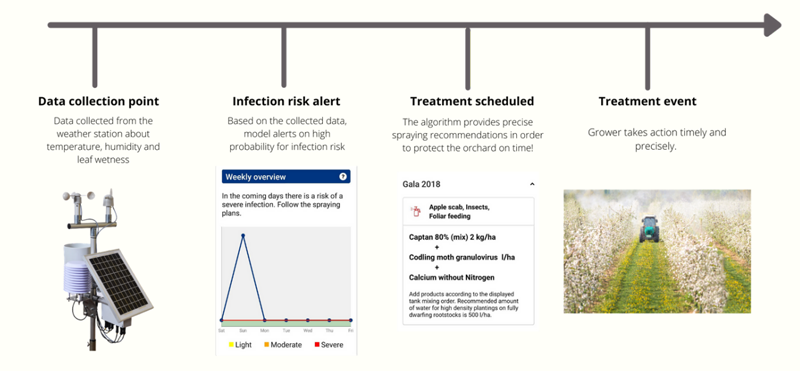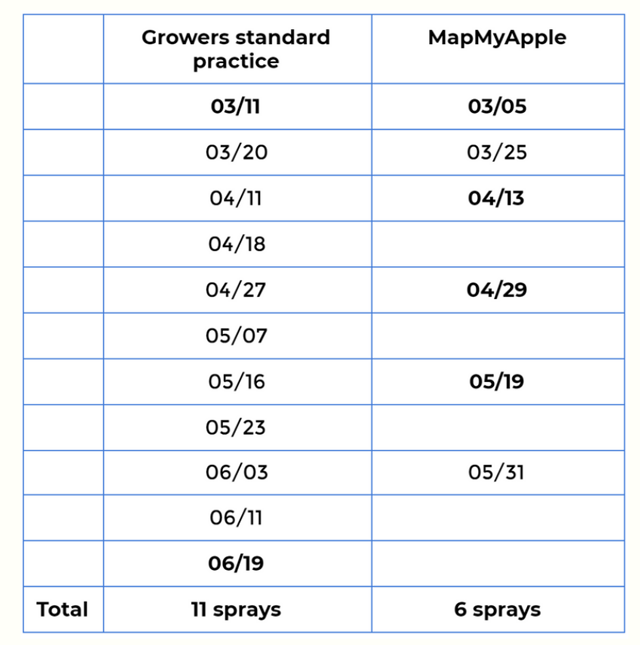MapMyApple collects data from the user’s orchard, runs it through the algorithms and the advanced disease models, determines if there is a need to spray, chooses the right product, and schedules a spraying activity for the selected block.
 Data-driven Platform to Maximize Orchard Efficiency
Data-driven Platform to Maximize Orchard Efficiency

White Paper from | Fresh Agriculture Technologies
Challenge
Apple production worldwide is constantly under pressure to increase yields, fruit quality, and safety, and, at the same time, reduce economic and environmental costs. Proper tackling of diseases and pests posing a threat to apple orchards is essential in achieving those goals. Correct timing of pesticide sprays and a good choice of active ingredient play a vital role in reducing costs while keeping the trees and fruits free from disease and pest damage.
Old, conservative spray programs, as a rule, result in an increased number of sprays, higher costs and more pesticides ending up in the environment, and higher residue levels. Data from apple farms in Southeast Europe shows pesticide overuse leading to a loss of up to 655€ per hectare per season. West and North Europe, as well as the US also show high potential for optimizing spraying activities and making saves.
Having that in mind, some growers try reducing the number of sprays. Without a suitable tool and strategy, they often fail, ending up with established infections, significantly lowering the fruit quality and yield.
Providing growers with critical information
Decision support systems take advantage of new technologies to respond to this challenge. The use of decision support systems in orchards is increasing, especially in tasks related to pest and disease prediction, detection, and planning of plant protection activities.
MapMyApple is a decision support system developed for professional apple growers. It brings the best knowledge and practices in apple protection, enforced with advanced disease and pest forecast models.
MapMyApple collects data from the user’s orchard, runs it through the algorithms and the advanced disease models, determines if there is a need to spray, chooses the right product, and schedules a spraying activity for the selected block. Some of the data collected are the weather data (including leaf wetness), location, rootstock, cultivar information, the year of planting, planting distance, and current growth stage. Historical pressure of diseases and pests is also taken into account. (Fig. 1)

Fig 1. Steps we take to advise on right spraying recommendation.
Growers are provided with complete plans for spraying and foliar nutrition, custom-made for the selected block, variety, and growing conditions. The list of diseases and pests MapMyApple predicts covers apple scab, fire blight, powdery mildew, sooty blotch and flyspeck, and codling moth. The recommendations are in line with the local PPP regulations, PHIs and MRLs.
Measuring performances at commercial apple farms
In the 2020 growing season, in order to test the potential for application in commercial apple production, we conducted a trial with applying MapMyApple spraying plans at a commercial apple farm. The farm is located in the Backa region, Serbia (45°2'N 19°4'E, 80 m.a.s.l, humid continental climate (Dfa subtype)). The orchard was planted in 2017. The cultivar selected for the trial was Golden Delicious, grafted on M9 T337 rootstock. The orchard is a 3000 trees/hectare high-density Tall Spindle orchard, with a between-row distance of 3.3m and an in-row distance of 1.0m. In the trial block, the grower did all spraying activities based on the MapMyApple plans. In the control block, the grower applied his standard spraying practice, with the support and advice of the local extension service.
Data presented in the table (Table 1.) shows the dates of the fungicide treatments conducted in the apple scab primary infection period in trial and control blocks.
The first mature spores in leaf litter were found on 02/18, and the first spores ready to be discharged were found on 02/25. The Green Tip date was 03/03. The apple scab primary infection period - the most intensive spraying period in apple - lasted from 03/03 until 06/12.
The significant infection periods were recorded on 03/06, 04/13, 04/29, and 05/19.
The MapMyApple spraying plans were performed a day ahead of the forecasted infection periods, using only contact (protective) fungicides. Protective fungicides are relatively inexpensive and spraying right ahead of the infection period made it possible to exclude curative fungicides and keep the pathogen resistance development risk at a low level.

Table 1. Comparison table - growers standard practice treatments versus MapMyApple.
By looking at the table (Table 1.), we notice that the standard grower’s practice missed covering the first infection period. That can allow the early scab infection to take place. Such early infections are dangerous because they invoke more intensive spraying programs in the summer, increase the plant protection costs and make it more challenging to keep the fruits clean and high-quality.
Using the standard practice and the advice of the local extension service, the grower struggled to precisely determine the end date of the scab primary infection period. That led to at least one extra spray (06/19). With MapMyApple, this date was precisely forecasted, and no extra pesticides were applied.
In the trial block, the grower managed to reduce the number of sprays by 5, from 11 to only 6. The yield and quality of fruits were not significantly different between the trial and control. The savings made by lowering the total amount of fungicides used were 300€/ha, just for the scab primary infection period and not taking the application costs (machinery, workers, etc.) into account.
Digitizing agronomy practices
The results show the potential for applying MapMyApple at commercial apple farms. More tests and trials will be conducted in the 2021 growing season. In a nutshell, pesticide overdose is a real problem happening in orchards around the globe. This trial shows that the timing and the proper spraying recommendations are incremental for reducing production costs while keeping the maximal yields. Ultimately, this is the value that MapMyApple provides to the growers and consultants.
The content & opinions in this article are the author’s and do not necessarily represent the views of AgriTechTomorrow
Comments (0)
This post does not have any comments. Be the first to leave a comment below.
Featured Product


